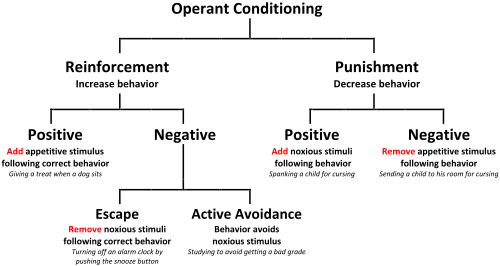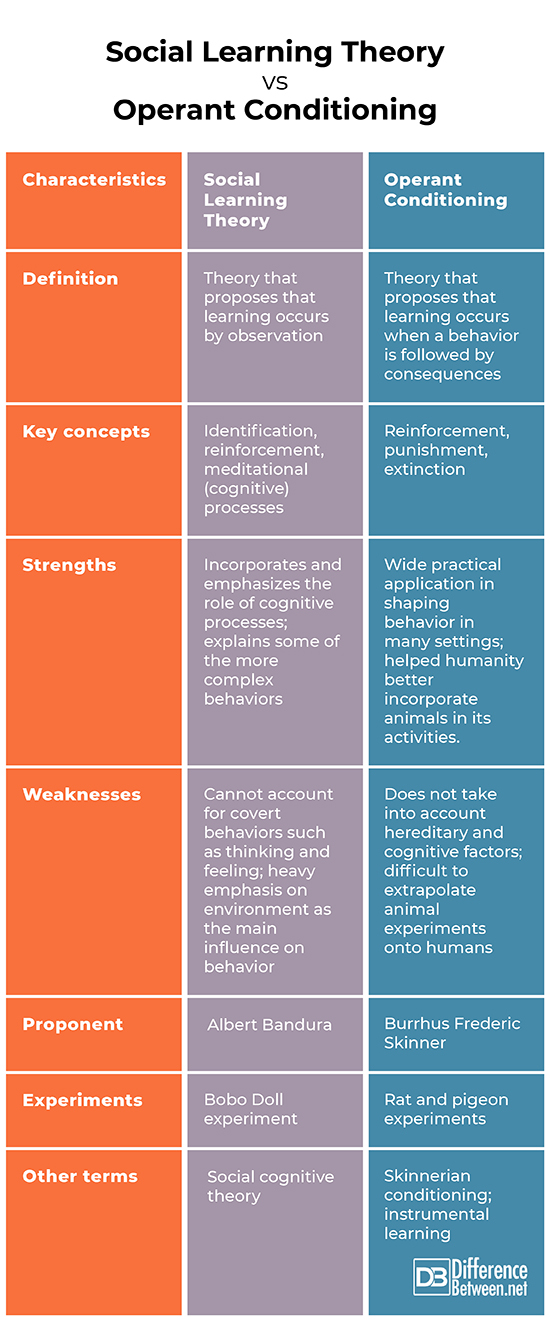Difference Between Social Learning Theory and Operant Conditioning
Social learning theory and operant conditioning are two theories that try to explain learning, the process by which new knowledge, behavior and values are acquired or old ones are modified. Although learning is observed in animals and even some plants, social learning and operant conditioning are focused on human behavior. Both theories were introduced in the mid 1900’s, and part of the broader behaviorist school of psychology which focuses on learned behavior, avoiding the ones that are internal or spontaneous.
The aim of both theories is to explain how learning occurs, but these theories were proposed by two different persons and came at different times. They each have a different focus on how learning occurs and the key concepts that define each one. Also unique are the different methods used to demonstrate their respective type of learning. More about each of these learning theories and their differences are discussed in the following sections.

What is Social Learning Theory?
Social learning theory proposes that learning occurs by observation. There are three main concepts in the process of social learning and these are identification, reinforcement and mediational processes. The process of learning starts with observation. People observe and copy the behavior of individuals they identify with, referred to as models. These models are quite influential, and one is likely to have many models; parents and teachers, friends and peers, or in this modern age, characters in the media. Not all behavior is copied though and this is where identification with the model strengthens the likelihood of a behavior being copied. Research has shown that people most identify with individuals it sees as similar in some way. There are of course many things that one may base similarity on but sex seems to be the most apparent, as daughters copy their mothers more often and sons their fathers. The observed behavior is then imitated at an appropriate time and is strengthened with reinforcement, either a direct reinforcement to the copied behavior or observed reinforcement to the model. Whether a behavior is imitated is affected by four mediational factors. First is attention, the degree to which a person is exposed to or notice the behavior of the model. Second is retention, how well the behavior is remembered. Third is reproduction, the ability to perform the behavior. Last is motivation, the will to perform the behavior after considering the consequences that came along with the observed behavior.
Albert Bandura is the proponent of the social learning theory which he later renamed as social cognitive theory because of the important role that cognitive factors play in the process of learning. This type of learning is most noticeable in children, as demonstrated in the Bobo Doll Experiment, where children learned to punch a bobo doll after seeing adults perform the behavior only once. Although the theory can explain a wide range of complex behavior, it still cannot adequately account for covert behaviors such as thinking and feeling. Also, as all behavioral theories do, it still puts too much emphasis on the environment, the nurture side of things, as the main influence on behavior.

What is Operant Conditioning?
Operant conditioning, also known as Skinnerian conditioning or instrumental learning, proposes that people learn by associating behavior with the consequences that follow. There are three key concepts to this theory, namely reinforcement, punishment and extinction. Reinforcement increases the likelihood that a person will repeat a behavior and it comes in two forms; positive and negative reinforcement. Positive reinforcement is the introduction of positive stimuli after a behavior, basically giving a reward. Negative reinforcement is the removal of pre-occurring adverse stimuli after performing the behavior. Punishment decreases the likelihood of repeating a behavior and also comes in two forms, although books generally call these forms collectively as punishment. The first one is the introduction of adverse stimuli after a specific behavior, basically a true punishment. The second form is the removal of positive stimuli after performing the behavior. The third component of operant conditioning is extinction, which is the process and rate that a behavior is forgotten once reinforcement or punishment is ended.
Burrhus Frederic Skinner was the foremost behavioral psychologist who worked on operant conditioning, and cleverly demonstrated this type of learning with his rat and pigeon experiments. The experimental subjects were subjected to positive and adverse stimuli at varying degree and intervals. Through these experiments he figured out that reinforcement is better at shaping behavior than punishment and at which degree and frequency to give the reinforcement for the behavior to be stronger and last longer. These findings have had wide practical applications, from classrooms to prisons and from rehabilitation centers to psychiatric hospitals, not to mention the benefit of having trained animals in the military and police as well as aides to disabled people. As a learning theory however, it does not take into account hereditary and cognitive factors. Also, there is an argument that we cannot generalize studies on animals to humans due to difference in anatomy and physiology.
Difference between Social Learning Theory and Operant Conditioning
Definition
Social learning theory proposes that learning occurs through observation while operant conditioning proposes that learning occurs when behavior is followed by consequences.
Key concepts
Key concepts in the social learning theory are identification with a model, reinforcement and meditational processes. Operant conditioning explains how reinforcement, punishment and extinction work.
Strengths
Social learning theory incorporates and emphasizes the role of cognitive processes and can explain some of the more complex behaviors. Operant conditioning has had a wide practical application in shaping behavior in many settings and has also helped humanity better incorporate animals in its activities.
Weaknesses
Social learning cannot account for covert behaviors such as thinking and feeling and has heavy emphasis on environment (nurture on the nature vs. nurture discussion) as the main influence on behavior. Operant conditioning does not take into account hereditary and cognitive factors and has the argument against it on extrapolating animal experiments onto humans.
Proponent
Albert Bandura is the proponent of social learning theory while B.F. Skinner was the foremost psychologist who worked on operant conditioning.
Famed experiments
Social learning was demonstrated in the Bobo Doll experiment, while Skinner demonstrated operant conditioning in his rat and pigeon experiments.
Other terminology
Social learning theory was later renamed by Bandura to social cognitive theory. Operant conditioning is also known as Skinnerian conditioning and instrumental learning.
Social Learning Theory vs Operant Conditioning

Summary
- Social learning theory and operant conditioning are two theories that try to explain how learning occurs. These are both behaviorist viewpoints which emphasize learned and overt behavior over internal or spontaneous behavior.
- Social learning theory was proposed by Albert Bandura. It theorizes that behavior is learned through observation.
- Operant conditioning was proposed by B.F. Skinner and demonstrated that reinforcement works to shape behavior.
- Difference Between Hematoma and Melanoma - February 9, 2023
- Difference Between Bruising and Necrosis - February 8, 2023
- Difference Between Brain Hematoma and Brain Hemorrhage - February 8, 2023
Search DifferenceBetween.net :
Leave a Response
References :
[0]Cherry, Kendra. "Learning Theories In Psychology." VeryWellMind. October 6, 2019. https://www.verywellmind.com/learning-theories-in-psychology-an-overview-2795082 (accessed November 22, 2019).
[1]McLeod, Saul A. "Bandura - Social Learning Theory." Simply Psychology. February 5, 2016. https://www.simplypsychology.org/bandura.html (accessed November 22, 2019).
[2]McLeod, Saul A. "Skinner - Operant Conditioning." Simply Psychology. January 21, 2018. https://www.simplypsychology.org/operant-conditioning.html (accessed November 22, 2019).
[3]Image credit: https://live.staticflickr.com/2505/3953558009_f1d2c7bae3_b.jpg
[4]Image credit: https://upload.wikimedia.org/wikipedia/commons/thumb/6/62/Operant_conditioning_diagram_rev.svg/500px-Operant_conditioning_diagram_rev.svg.png
